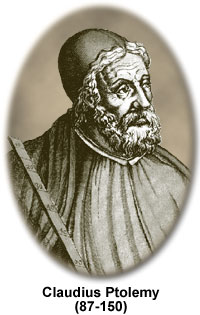Ptolemy's Geocentric model of the Solar System
Diary entry 1&2: Introducing Ptolemey and his model of the universe
I am Claudius Ptolemy, I was born in 100AD in Egypt under the Roman Empire. I was a Greece-Egyptian writer, known as a mathematician, astronomer, geographer, astrologer, and poet of a single epigram in the Greek Anthology. My model of the solar system and heavenly sphere was a refinement of previous models developed by Greek astronomers. Portrait of Claudius Ptolmey
Portrait of Claudius Ptolmey My Geocentric model or The Ptolemaic model accounted for the apparent motions of the planets in a very direct way, by assuming that each planet moved on a small sphere or circle, called an epicycle, that moved on a larger sphere or circle, called a deferent. The deferent is a circle whose center point, called the eccentric and marked in the diagram with an X (See below) , is removed from the Earth. The original purpose of the eccentric was to account for the differences of the lengths of the seasons , by placing the Earth away from the center of rotation of the rest of the universe. Another sphere, the epicycle, is embedded inside the deferent sphere and is represented by the smaller dotted line to the right.
 The Ptolemaic model.
The Ptolemaic model. Diary entry 3&4 Current theories and ideas about the universe
These changes could be explained by the varying rates at which the celestial bodies revolved around the Earth. However, the planets, behaved in ways that were difficult to explain. Sometimes, these wanderers showed retrograde motion—they seemed to stop and move in a reverse direction when viewed against the background of the distant constellations, or fixed stars, which did not move relative to one another. The stars were thought to be on a celestial sphere, with the Earth at its center, that rotated each day, using a line through the north and south pole as an axis. The stars closest to the equator appeared to rise and fall the greatest distance, but each star circled back to its rising point each day. The second observation supporting the Geocentric model was that the Earth does not seem to move from the perspective of an Earth-bound observer, and that it is solid, stable, and unmoving.
The video of the Ptolemaic Planetary model:
To explain the motion of the planets, Claudius Ptolemy (c. 90-168 A.D.), devised complicated models in which planets moved along circles (epicycles) that were superimposed on circular orbits about the Earth. These geocentric models were able to explain, for example, why Mercury and Venus never move more than 28° and 47° respectively from the Sun.
The model provided a reasonably accurate system for predicting the positions of heavenly bodies in the sky.
There were more flaws into the Geocentric model:
- Was not able to explain nearness of mercury and venus to sun.
- Didn't explain why planets are brighter when opposite to sun in the sky.
- Actually stars didn't orbit the earth but earth's rotation is the reason that makes the stars look as if they are orbiting the earth.
Here's the link to the retrograde of the planets in the Geogentric Model:
http://users.clas.ufl.edu/ufhatch/pages/03-Sci-Rev/SCI-REV-Home/resource-ref-read/chief-systems/08-0retro-2.htm
However, the ancient Greeks believed that the motions of the planets were circular and not elliptical, a view that was not challenged in Western culture until the 17th century through the synthesis of theories by Copernicus and Kepler.
 Geocentric model with epicycles. This is showing that the Greeks had found out that the orbits were circular and not elliptical.
Geocentric model with epicycles. This is showing that the Greeks had found out that the orbits were circular and not elliptical.
Diary entry 5&6 Limitations placed on the Model, and how would I do it with the technology now
Back then, the technology was just looking up at the night sky with out lights and observing the night sky. There was social beliefs and religion beliefs of the night sky also. That it was all by the naked eye, by Ptolemy that he went out at night to study the orbits, planets and the stars with his eye cause there was no telescope till 1400 years later.If I had the technology now:
- I can head over to the nearest observer and look at the Solar System.
- I can make a telescope at home.
- I can search about the Universe or the Solar System on the internet.
- Talk about it to the scientists or my friends who have good knowledge on the Solar System.
Conclusion
In the end. The Geocentric model was the incorrect model for the Solar System, cause there were no such things as epicycles, Was not able to explain nearness of mercury and venus to sun, Didn't explain why planets are brighter when opposite to sun in the sky, Actually stars didn't orbit the earth but earth's rotation is the reason that makes the stars look as if they are orbiting the earth. And that it was one of the most complicated models to exist. But the reason to the Geocentric model's complicated epicycles is because there was no technology back then, that it was all just used by the naked eye. Ptolemy
Bibliography:
http://www.universetoday.com/32607/geocentric-model/http://users.clas.ufl.edu/ufhatch/pages/03-Sci-Rev/SCI-REV-Home/resource-ref-read/chief-systems/08-0retro-2.htm